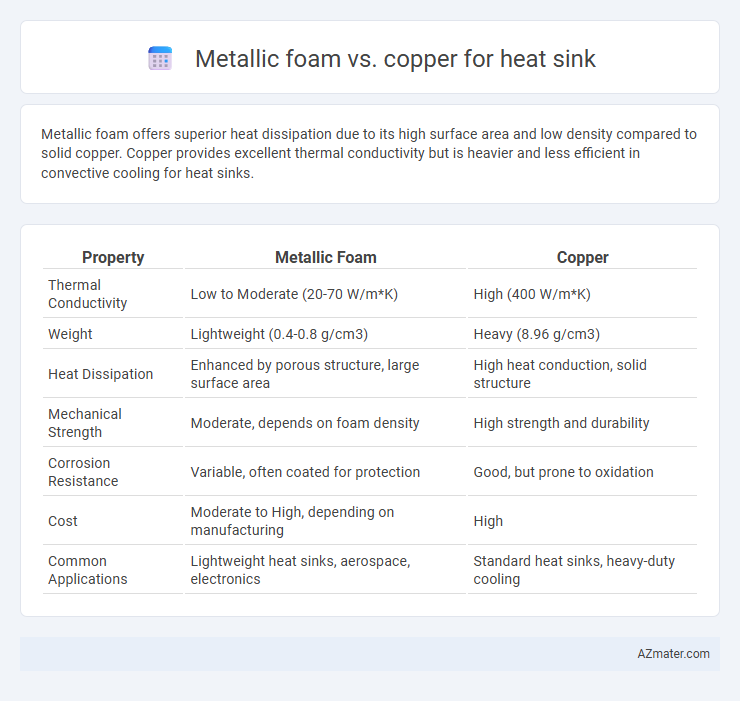Metallic foam offers superior heat dissipation due to its high surface area and low density compared to solid copper. Copper provides excellent thermal conductivity but is heavier and less efficient in convective cooling for heat sinks.
Table of Comparison
| Property | Metallic Foam | Copper |
|---|---|---|
| Thermal Conductivity | Low to Moderate (20-70 W/m*K) | High (400 W/m*K) |
| Weight | Lightweight (0.4-0.8 g/cm3) | Heavy (8.96 g/cm3) |
| Heat Dissipation | Enhanced by porous structure, large surface area | High heat conduction, solid structure |
| Mechanical Strength | Moderate, depends on foam density | High strength and durability |
| Corrosion Resistance | Variable, often coated for protection | Good, but prone to oxidation |
| Cost | Moderate to High, depending on manufacturing | High |
| Common Applications | Lightweight heat sinks, aerospace, electronics | Standard heat sinks, heavy-duty cooling |
Introduction to Heat Sink Materials
Metallic foam and copper are prominent materials used in heat sinks due to their thermal conductivity and structural properties. Copper offers high thermal conductivity, approximately 400 W/mK, making it efficient for rapid heat dissipation in electronic cooling applications. Metallic foam, characterized by its porous structure, provides enhanced surface area and reduced weight, improving convective heat transfer while maintaining adequate thermal performance.
Overview of Metallic Foam
Metallic foam offers superior thermal management due to its high surface area and excellent heat dissipation capabilities compared to traditional solid copper heat sinks. Its porous structure significantly reduces weight while maintaining mechanical strength, making it ideal for applications requiring efficient cooling and lightweight materials. The enhanced convective heat transfer in metallic foam improves overall cooling performance in electronic devices and industrial systems.
Properties of Copper as a Heat Sink
Copper's exceptional thermal conductivity of approximately 400 W/m*K makes it one of the best materials for heat sinks, enabling rapid heat dissipation in electronic devices. Its high density and excellent corrosion resistance also contribute to durability and long-term performance under varied environmental conditions. Despite being heavier and more expensive than metallic foam, copper's superior thermal efficiency ensures optimal cooling in high-power applications.
Thermal Conductivity Comparison
Metallic foam exhibits lower thermal conductivity compared to copper, typically ranging between 20 to 60 W/m*K due to its porous structure, while copper boasts a high thermal conductivity of approximately 400 W/m*K, making it highly efficient for heat dissipation. The reduced thermal conductivity in metallic foam is offset by its increased surface area and lightweight properties, enhancing convective heat transfer in specific applications. Copper remains the preferred material for heat sinks requiring rapid heat conduction and minimal thermal resistance.
Weight and Density Considerations
Metallic foam offers significantly lower density compared to copper, making it ideal for lightweight heat sink applications where minimizing weight is crucial. Copper, with a density of approximately 8.96 g/cm3, provides superior thermal conductivity but adds substantial weight to electronic devices. The porous structure of metallic foam reduces overall mass while maintaining adequate heat dissipation, offering an efficient balance between thermal performance and weight constraints.
Surface Area and Heat Dissipation Efficiency
Metallic foam offers a significantly higher surface area compared to solid copper, enhancing convective heat transfer in heat sinks. This porous structure increases turbulence and airflow, resulting in improved heat dissipation efficiency despite copper's superior thermal conductivity. The combination of expanded surface area and adequate thermal conductivity often makes metallic foam a more effective material choice for high-performance cooling applications.
Manufacturing and Cost Analysis
Metallic foam heat sinks offer advantages in manufacturing due to their lightweight, porous structure enabling efficient cooling with reduced material use, but they often require complex fabrication techniques such as investment casting or additive manufacturing, increasing production costs. Copper heat sinks, valued for superior thermal conductivity around 400 W/m*K, are traditionally manufactured via well-established processes like extrusion, stamping, and CNC machining, resulting in lower unit costs and easier scalability. Cost analysis reveals metallic foam heat sinks incur higher initial expenses but can achieve weight and material savings in applications where thermal performance per weight ratio is critical, whereas copper remains cost-effective for standard, high-performance heat dissipation needs.
Corrosion Resistance and Durability
Metallic foam heat sinks offer superior corrosion resistance compared to copper due to their porous structure and potential for protective coatings that inhibit oxidation and chemical degradation. Copper, while highly conductive, is prone to tarnishing and corrosion in harsh environments, which can reduce its thermal performance and lifespan. The enhanced durability of metallic foam under aggressive conditions makes it a preferred choice for applications requiring long-term reliability and minimal maintenance.
Application Suitability in Electronics
Metallic foam offers superior thermal management and lightweight properties, making it ideal for high-performance electronics requiring efficient heat dissipation with minimal weight. Copper excels in thermal conductivity and mechanical strength but is heavier and less effective in applications where weight reduction is critical. For compact, portable electronic devices, metallic foam heat sinks provide a better balance of thermal efficiency and design flexibility compared to copper.
Environmental Impact and Sustainability
Metallic foam heat sinks offer enhanced thermal management with lower material usage and reduced weight, contributing to lower resource extraction and energy consumption during production. Copper, while highly efficient in heat conduction, has a higher environmental footprint due to intensive mining processes and greater energy demands for extraction and recycling. The sustainability advantage of metallic foam lies in its potential for recyclability combined with reduced raw material requirements, making it a more eco-friendly choice for thermal management applications.

Infographic: Metallic foam vs Copper for Heat sink
 azmater.com
azmater.com